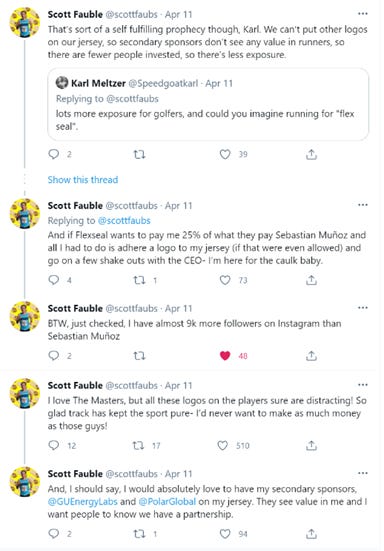The Undervalued Runner
Over 9.5M Americans tuned in to watch Hediki Matsuyama become Japan’s first Master’s champion. The win earned him the famous Green Jacket, a $2M purse and yes.. an estimated $0.6B to $1B in future endorsement deals.
This endorsement estimate represents a near 30,000% – 50,000% increase in his winnings from that day. Even before his Master’s win, Matsuyama was making an estimated $8M – $10M in endorsement deals annually. While minimal in comparison to his new estimates, this is still a 100%-200% more than the $3.6M he made playing golf last year. With 9.45M viewers, it is obvious why brands such as Srixon, Lexus, Indeed, Nomura Financial, Oakley decide to sponsor Matsuyama.
Of those 9.5M viewers, one of them was Scott Fauble. Scott is an American distance runner. One of the best, actually. He finished first amongst Americans at the 2019 Boston Marathon, just ahead of 2016 US Olympic representative Jared Ward.

While watching the Masters, Fauble began to take notice of all the logos emblazed on each of the golfer’s chest, back, shoulders, sleeves, and hat. Recognizing the income these golfers were making by simply putting the logos on their clothing, Fauble found himself frustrated. The governing body in US professional running is the USTF and they make it illegal to wear any logos (aside from the clothing and shoe manufacturer) during competition. This, Fauble believes, is what is holding the sport back.
“[Because] we can’t put other logos on our jersey, secondary sponsors don’t see any value in runners, there are fewer people invested, so there’s less exposure.”
When assessing the attractiveness for advertises between the sport of running and the sport of golf, running begins to look extremely attractive.
According to a 2017 (most recent) report by the Sports & Fitness Industry Association, there are an estimated 47M runners in the United States with over half, 23.5M participating at least once a week. Golf, a more commonly once-a-week sport, is estimated to have 24.8M participants. Yet this estimate includes those who have only played just one round in the entire year. When comparing daily participation, running seems to garner more interest than golf.
So what about TV viewership? Yes, Golf dominates here. But as Fauble is quick to point out that this is because of a never-ending cycle.
That said, while the Masters peaked at 9.45M viewers the 2016 Rio Summer Olympic Games saw a daily average of 27.5M viewers in the US alone. And which sport constantly ranked in the top 3 of most watched from the last Olympic games? Track and field.
Likewise, the top running events such as the NYC Marathon draw attendance of 2.5M people. This is the equivalent of the entire TV viewership of the 2nd round of the Masters (2.6M) and nearly a 1M more than that of the first round of this year’s Masters (1.7M).
But surely Golfers have a bigger personal following than runners, right? Fauble, who has 21K people following him on Instragram keenly dismisses this fact by noting that one sponsor – Flex Seal – sponsors golfer Sebastian Munoz whose social media following of 11K people is nearly half of his.
In fact, Scott posts very regularly on Instagram and Twitter and has built a dedicated audience. His 21K followers and 812 posts was actually more than that of Matsuyama’s (5K followers[JH1] , 14 posts) prior to Masters weekend. Matsuyama is also widely known as a very person. From this perspective, Fauble seems like an equally attractive candidate for sponsors as is Matsuyama.
Yet, he could only dream of things like $600M in endorsements.
In just 3 short months the eyes of the sports world will again be on Japan. Not because of golf, but because of athletes like Scott.
The Tokyo Olympics are set to begin on July 23rd. With daily viewership being nearly twice that of the Masters, it would behoove the USATF to take notice of the momentum and interest generated by the Olympics and start to allow their athletes to put logos on their jerseys.
If played strategically, we could see the sport’s value rise by 30,000% – 50,000%.
